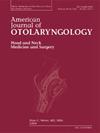Outcomes after radiofrequency neurolysis of the posterior nasal nerve for treating Chinese adults with moderate to severe allergic rhinitis
IF 1.7
4区 医学
Q2 OTORHINOLARYNGOLOGY
引用次数: 0
Abstract
Background
Temperature-controlled radiofrequency ablation (TCRA) represents a minimally invasive alternative to surgical posterior nasal neurectomy for the management of allergic rhinitis (AR). However, to date, the impact of this minimally invasive operation on Chinese adult individuals suffering from AR remains unclear.
Objectives
To assess the safety and efficacy of TCRA for the treatment of perennial moderate and severe AR in Chinese adults.
Methods
This retrospective case-control study included 48 consecutive patients assigned to two groups: one received TCRA and the other received posterior nasal neurectomy (PNN). Follow-up assessments were conducted at 11–13 months post-surgery. The reflective total nasal symptom score (rTNSS), total non-nasal symptom score (rTNNSS), total rhinitis medication score (TRMS), and total nasal resistance were measured both preoperatively and postoperatively.
Results
At the tertiary endpoint, the TCRA group demonstrated an 73.1 % improvement in rTNSS compared to baseline, while the PNN group showed a 74.0 % improvement. However, the mean change in rTNNSS at the tertiary endpoint was 72.7 % for the TCRA group and 73.1 % for the PNN group. The mean change in TRMS from baseline to the tertiary endpoint was 68.8 % for the TCRA group and 70.9 % for the PNN group. TCRA yielded a striking 62.5 % reduction in total nasal resistance. Notably, a positive linear correlation was observed between the subjective and objective assessments of nasal resistance at baseline, the secondary and the tertiary endpoints.
Conclusion
The findings suggest that the minimally invasive TCRA technique, as a safe and effective surgical procedure, can provide a novel and superior alternative to PNN for Chinese adults with AR.
鼻后神经射频松解术治疗中国成人中重度变应性鼻炎的疗效
背景:温控射频消融(TCRA)是治疗变应性鼻炎(AR)的一种微创替代手术后鼻神经切除术。然而,迄今为止,这种微创手术对中国成人AR患者的影响尚不清楚。目的评价TCRA治疗中国成人常年性中重度AR的安全性和有效性。方法回顾性病例对照研究将48例患者分为两组:一组接受TCRA,另一组接受鼻后神经切除术(PNN)。术后11-13个月进行随访评估。术前、术后分别测量鼻症状总评分(rTNSS)、非鼻症状总评分(rTNNSS)、鼻炎用药总评分(TRMS)和鼻总阻力。结果在第三终点,与基线相比,TCRA组rTNSS改善了73.1%,而PNN组改善了74.0%。然而,第三终点rTNNSS的平均变化在TCRA组为72.7%,在PNN组为73.1%。TCRA组从基线到第三终点的TRMS平均变化为68.8%,PNN组为70.9%。TCRA显著降低了鼻腔总阻力62.5%。值得注意的是,在基线,次要和第三个终点,主观和客观的鼻阻力评估之间观察到正线性相关。结论微创TCRA技术作为一种安全、有效的手术方法,为我国成人AR患者提供了一种新颖、优越的替代方案。
本文章由计算机程序翻译,如有差异,请以英文原文为准。
求助全文
约1分钟内获得全文
求助全文
来源期刊

American Journal of Otolaryngology
医学-耳鼻喉科学
CiteScore
4.40
自引率
4.00%
发文量
378
审稿时长
41 days
期刊介绍:
Be fully informed about developments in otology, neurotology, audiology, rhinology, allergy, laryngology, speech science, bronchoesophagology, facial plastic surgery, and head and neck surgery. Featured sections include original contributions, grand rounds, current reviews, case reports and socioeconomics.
 求助内容:
求助内容: 应助结果提醒方式:
应助结果提醒方式:


